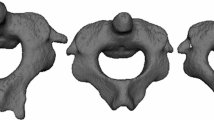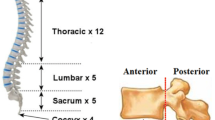Abstract
Summary
Quantitative vertebral morphometry (QVM) was performed by parametric modeling of vertebral bodies in three dimensions (3D).
Introduction
Identification of vertebral fractures in two dimensions is a challenging task due to the projective nature of radiographic images and variability in the vertebral shape. By generating detailed 3D anatomical images, computed tomography (CT) enables accurate measurement of vertebral deformations and fractures.
Methods
A detailed 3D representation of the vertebral body shape is obtained by automatically aligning a parametric 3D model to vertebral bodies in CT images. The parameters of the 3D model describe clinically meaningful morphometric vertebral body features, and QVM in 3D is performed by comparing the parameters to their statistical values. Thresholds and parameters that best discriminate between normal and fractured vertebral bodies are determined by applying statistical classification analysis.
Results
The proposed QVM in 3D was applied to 454 normal and 228 fractured vertebral bodies, yielding classification sensitivity of 92.5 % at 7.5 % specificity, with corresponding accuracy of 92.5 % and precision of 86.1 %. The 3D shape parameters that provided the best separation between normal and fractured vertebral bodies were the vertebral body height and the inclination and concavity of both vertebral endplates.
Conclusion
The described QVM in 3D is able to efficiently and objectively discriminate between normal and fractured vertebral bodies and identify morphological cases (wedge, (bi)concavity, or crush) and grades (1, 2, or 3) of vertebral body fractures. It may be therefore valuable for diagnosing and predicting vertebral fractures in patients who are at risk of osteoporosis.




Similar content being viewed by others
References
Johnell O, Kanis J (2005) Epidemiology of osteoporotic fractures. Osteoporosis Int 16:S3–S7
Ferrar L, Jiang G, Adams J, Eastell R (2005) Identification of vertebral fractures: an update. Osteoporos Int 16(7):717–728
Melton L, Atkinson E, Cooper C, O’Fallon W, Riggs B (1999) Vertebral fractures predict subsequent fractures. Osteoporos Int 10(3):214–221
Gehlbach SH, Bigelow C, Heimisdottir M, May S, Walker M, Kirkwood JR (2000) Recognition of vertebral fracture in a clinical setting. Osteoporos Int 11(7):577–582
Delmas PD, van de Langerijt L, Watts NB, Eastell R, Genant H, Grauer A, Cahall DL (2005) Underdiagnosis of vertebral fractures is a worldwide problem: the IMPACT study. J Bone Miner Res 20(4):557–563
Genant HK, Wu CY, van Kuijk C, Nevitt MC (1993) Vertebral fracture assessment using a semiquantitative technique. J Bone Miner Res 8(9):1137–1148
Schousboe JT, Vokes T, Broy SB, Ferrar L, McKiernan F, Roux C, Binkley N (2008) Vertebral fracture assessment: the 2007 ISCD official positions. J Clin Densitom 11(1):92–108
Jiang G, Eastell R, Barrington NA, Ferrar L (2004) Comparison of methods for the visual identification of prevalent vertebral fracture in osteoporosis. Osteoporos Int 15(11):887–896
Ferrar L, Jiang G, Schousboe JT, DeBold CR, Eastell R (2008) Algorithm-based qualitative and semiquantitative identification of prevalent vertebral fracture: agreement between different readers, imaging modalities, and diagnostic approaches. J Bone Miner Res 23(3):417–424
Minne H, Leidig G, Wuster C, Siromachkostov L, Baldauf G, Bickel R, Sauer P, Lojen M, Ziegler R (1988) A newly developed spine deformity index (SDI) to quantitate vertebral crush fractures in patients with osteoporosis. Bone Miner 3(4):335–349
Melton L, Kan SH, Frye MA, Wahner HW, O’Fallon WM, Riggs BL (1989) Epidemiology of vertebral fractures in women. Am J Epidemiol 129(5):1000–1011
Eastell R, Cedel SL, Wahner HW, Riggs BL, Melton LJ 3rd (1991) Classification of vertebral fractures. J Bone Miner Res 6(3):207–215
McCloskey EV, Spector TD, Eyres KS, Fern ED, O’Rourke N, Vasikaran S, Kanis JA (1993) The assessment of vertebral deformity: a method for use in population studies and clinical trials. Osteoporos Int 3(3):138–147
Genant HK, Jergas M, Palermo L, Nevitt M, Valentin RS, Black D, Cummings SR (1996) Comparison of semiquantitative visual and quantitative morphometric assessment of prevalent and incident vertebral fractures in osteoporosis. J Bone Miner Res 11(7):984–996
Smyth PP, Taylor CJ, Adams JE (1999) Vertebral shape: automatic measurement with active shape models. Radiology 211(2):571–578
de Bruijne M, Lund MT, Tankó LB, Pettersen PC, Nielsen M (2007) Quantitative vertebral morphometry using neighbor-conditional shape models. Med Image Anal 11(5):503–512
Brett A, Miller CG, Hayes CW, Krasnow J, Ozanian T, Abrams K, Block JE, van Kuijk C (2009) Development of a clinical workflow tool to enhance the detection of vertebral fractures: accuracy and precision evaluation. Spine 34(22):2437–2443
Roberts M, Cootes TF, Adams JE (2006) Vertebral morphometry—semiautomatic determination of detailed shape from dual-energy X-ray absorptiometry images using active appearance models. Invest Radiol 41(12):849–859
Roberts M, Cootes T, Pacheco E, Adams J (2007) Quantitative vertebral fracture detection on DXA images using shape and appearance models. Acad Radiol 14(10):1166–1178
Roberts M, Pacheco EMB, Mohankumar R, Cootes TF, Adams JE (2010) Detection of vertebral fractures in DXA VFA images using statistical models of appearance and a semi-automatic segmentation. Osteoporos Int 21(12):2037–2046
Roberts M, Oh T, Pacheco EMB, Mohankumar R, Cootes TF, Adams JE (2012) Semi-automatic determination of detailed vertebral shape from lumbar radiographs using active appearance models. Osteoporos Int 23(2):655–664
Kim YM, Demissie S, Eisenberg R, Samelson EJ, Kiel DP, Bouxsein ML (2011) Intra- and inter-reader reliability of semi-automated quantitative morphometry measurements and vertebral fracture assessment using lateral scout views from computed tomography. Osteoporos Int 22(10):2677–2688
Kim YM, Demissie S, Genant HK, Cheng X, Yu W, Samelson EJ, Kiel DP, Bouxsein ML (2012) Identification of prevalent vertebral fractures using CT lateral scout views: a comparison of semi-automated quantitative vertebral morphometry and radiologist semi-quantitative grading. Osteoporos Int 23(3):1007–1016
Ito Z, Harada A, Matsui Y, Takemura M, Wakao N, Suzuki T, Nihashi T, Kawatsu S, Shimokata H, Ishiguro N (2006) Can you diagnose for vertebral fracture correctly by plain X-ray? Osteoporos Int 17(11):1584–1591
Kolta S, Quiligotti S, Ruyssen-Witrand A, Amido A, Mitton D, Bras AL, Skalli W, Roux C (2008) In vivo 3D reconstruction of human vertebrae with the three-dimensional X-ray absorptiometry (3D-XA) method. Osteoporos Int 19(2):185–192
Kolta S, Kerkeni S, Travert C, Skalli W, Eastell R, Glüer CC, Roux C (2012) Variations in vertebral body dimensions in women measured by 3D-XA: a longitudinal in vivo study. Bone 50(3):777–783
Woo EK, Mansoubi H, Alyas F (2008) Incidental vertebral fractures on multidetector CT images of the chest: prevalence and recognition. Clin Radiol 63(2):160–164
Williams AL, Al-Busaidi A, Sparrow PJ, Adams JE, Whitehouse RW (2009) Under-reporting of osteoporotic vertebral fractures on computed tomography. Eur J Radiol 69(1):179–183
Parizel PM, Zijden T, Gaudino S, Spaepen M, Voormolen MHJ, Venstermans C, Belder F, den Hauwe L, Goethem JV (2009) Trauma of the spine and spinal cord: imaging strategies. Eur Spine J 19(S1):8–17
Štern D, Likar B, Pernuš F, Vrtovec T (2011) Parametric modelling and segmentation of vertebral bodies in 3D CT and MR spine images. Phys Med Biol 56(23):7505–7522
Panjabi MM, Takata K, Goel V, Federico D, Oxland T, Duranceau J, Krag M (1991) Thoracic human vertebrae. Quantitative three-dimensional anatomy. Spine 16(8):888–901
Panjabi MM, Goel V, Oxland T, Takata K, Duranceau J, Krag M, Price M (1992) Human lumbar vertebrae. Quantitative three-dimensional anatomy. Spine 17(3):299–306
Masharawi Y, Salame K, Mirovsky Y, Peleg S, Dar G, Steinberg N, Hershkovitz I (2008) Vertebral body shape variation in the thoracic and lumbar spine: characterization of its asymmetry and wedging. Clin Anat 21(1):46–54
Štern D, Likar B, Pernuš F, Vrtovec T (2010) Automated detection of spinal centrelines, vertebral bodies and intervertebral discs in CT and MR images of lumbar spine. Phys Med Biol 55(1):247–264
Guglielmi G, Stoppino LP, Placentino MG, D’Errico F, Palmieri F (2009) Reproducibility of a semi-automatic method for 6-point vertebral morphometry in a multi-centre trial. Eur J Radiol 69(1):173–178
Acknowledgments
This work has been supported by the Ministry of Education, Science, Culture and Sport, Slovenia, under grants P2-0232, J7-2246, J2-0716, and L2-2023. The authors would like to thank the Clinical Center of Vojvodina, Serbia, for providing the images used in the experiments.
Conflicts of interest
None
Author information
Authors and Affiliations
Corresponding author
Rights and permissions
About this article
Cite this article
Štern, D., Njagulj, V., Likar, B. et al. Quantitative vertebral morphometry based on parametric modeling of vertebral bodies in 3D. Osteoporos Int 24, 1357–1368 (2013). https://doi.org/10.1007/s00198-012-2089-4
Received:
Accepted:
Published:
Issue Date:
DOI: https://doi.org/10.1007/s00198-012-2089-4




